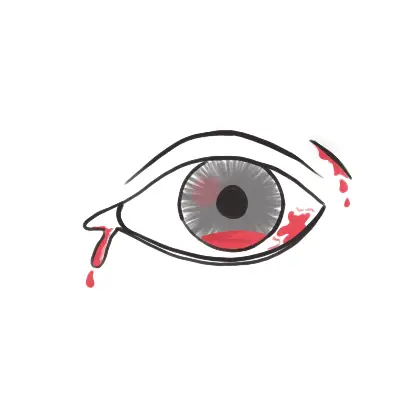Remember
Wounds require tetanus prophylaxis and broad spectrum antibiotic if significant risk of contamination, or debridement of necrotic tissue.
History
Likely foreign body Which eye Mechanism Protective eye wear? Previous eye trauma – reduced structural integrity When did it happen? Contact lens wearer What are the symptoms?Photophobia Discharge and type Side note Small projectiles at high velocities increase the likelihood of penetrating trauma. Symptoms include loss of vision, pain on movement and diplopia.
Features requiring urgent referral Contact lens wearer Previous eye surgery or refractive surgery Decreased vision Severe pain Nausea and vomiting Cloudy or opaque cornea Dendritic ulcer Hypopyon (pus in the anterior chamber) Nonreactive pupils or RAPD Ocular trauma Persisting or worsening symptoms Chemical to eye
Blunt trauma
TypesClosed globe injury Ruptured globe SignsHaemorrhage Hyphaema Vitreous Retina → retinal detachment Vision changesIris damage Lens damaged or dislocated Angle of eye drainage damage Investigate: CT scan for orbital wall fracture Management: Topical antibiotics and suture eye lid lacerations and urgent referral Signs of an inferior blowout fracture Ecchymosis/oedema Diplopia A recessed eye Defective eye movement Ipsilateral nose bleed Diminished sensation over the distribution of the infraorbital nerve
Penetrating trauma
Prolapse of the intraocular contents and irreversible damage can occur Signs:Distorted pupil Cataract Prolapsed black uveal tissue on the ocular surface Vitreous haemorrhage Dilate pupil and search for intraocular foreign bodyRadiograph with eye in up and down gaze Apply shield and transfer to eye department All penetrating eye injuries need immediate referral Management:Nil by mouth Strict bed rest Analgesia/antiemetic CT Shield (not pad) Tetanus status Broad spectrum antibiotics Corneal foreign body
Any foreign body penetration of the cornea or retained foreign body will require urgent referral to ophthalmologist – immediate consult by phone Management removing corneal foreign bodyTopical anaesthetic Slit lamp and remove bodyCotton bud Fine needle Motorised dental burr Use fluorescein to assess and measure the size of epithelial defect Topical antibiotics and cycloplegic agent Refer to ophthalmologist if body not removed and symptoms worsen Chemical Burns Management
Instil local anaesthetic drops to affected eye/eyes. Commence irrigation with 1 litre of a neutral solution, eg N/Saline (0.9%), Hartmann’s. Evert the eyelid and clear the eye of any debris / foreign body that may be present by sweeping the conjunctival fornices with a moistened cotton bud. Continue to irrigate, aiming for a continuous irrigation with giving set regulator fully open.If using a Morgan Lens, carefully insert the device now. Review the patient’s pain level every 10 minutes and instil another drop of local anaesthetic as required. After one litre of irrigation, review.If using a Morgan Lens, remove the device prior to review. Wait 5 minutes after ceasing the irrigation luid then check pH. Acceptable pH range 6.5-8.5. Consult with the senior medical oficer and recommence irrigation if necessary. Severe burns will usually require continuous irrigation for at least 30 minutes Immediate referral Alkali Acidic Lime Toilet cleaner Mortor & plaster Car battery fluid Drain cleaner Pool cleaner Oven cleaner Ammonia



Discussion